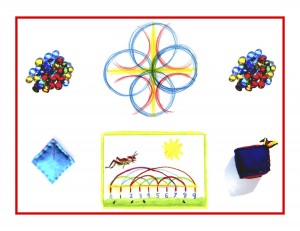Day 142
For one year, 365 days, this blog will address the Common Core Standards from the perspective of creating an alternate, ambient learning environment for math. Ambient is defined as “existing or present on all sides, an all-encompassing atmosphere.” And ambient music is defined as: “Quiet and relaxing with melodies that repeat many times.
Why ambient? A math teaching style that’s whole and all encompassing, with themes that repeat many times through the years, is most likely to be effective and successful. Back to our hero, Saint Francis, and anti-hero, Reynard Fox, tomorrow. For today, an observation re a Facebook post and a question: “Should elementary students’ work be beautiful and colorful, or is this unimportant, even irrelevant?”
The Facebook post was an image of a second grader’s homework, posted by her mom and reposted on my page. The assignment was to “Write all the ways to make 16 using counters and every dot has a partner.” (See image below.) Mom was unable to decode the assignment and said that her daughter needed to do her best on her own. The result was somewhat successful but not aesthetically pleasing, certainly not beautiful.
This got me thinking about the Waldorf imperative that all student work be beautiful related to the idea that the focus of middle childhood (from ages 7-14) be based on the beautiful and artistic. The three virtues of Goodness, Beauty, and Truth apply to the three stages of childhood in this way: Goodness to the baby and young child from 0-7, Beauty to the elementary-age child, ages 7-14, and Truth to the teen-young adult, ages 14-21.
Education modeled on these virtues at these ages looks exactly like Waldorf, wherever and however it happens, in a classroom or at home. Goodness surrounds the birth-7 year old child up through Kindergarten, in an environment that’s homey, family-oriented, and focused on play, crafts, cooking, and homemaking arts. From ages 7-14 there’s a deep desire to learn, but the mature stage of brain development that would make “executive function” learning possible has not yet happened.
At puberty, this higher level reasoning does become available, allowing learning to now be more abstract and logically-based. These stages of child-development are reflected in the work of many experts, Piaget and Steiner among them. Beauty and art then, function as a necessary buffer or translator, and as such must be consistently, inextricably integrated with all that is taught and learned for ages 7-14.
In light of this, look at the second image below, an illustration of the number 12 as the King of Numbers as it’s presented in Grade 1. The theory is that 12 is the richest in factors, compared to the numbers 4, 6, and 13, and this concept is brought back again and again until factors are formally taught, later on. Beyond the question of whether the sort of reasoning demanded by Common Core is developmentally appropriate (it’s not), is the imperative that all of the children’s work be beautiful.
Knowledge ensues in an environment dedicated to imaginative, creative knowing, where student and teacher alike surrender to the ensuing of knowledge as a worthy goal. Tune in tomorrow for more on the Grade 2 language arts content, before moving on to the Common Core ELA standards and their ambient counterparts.














